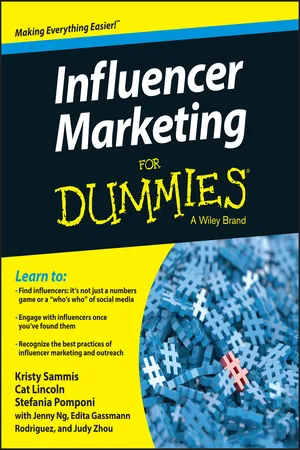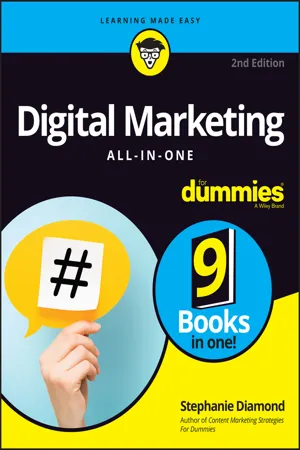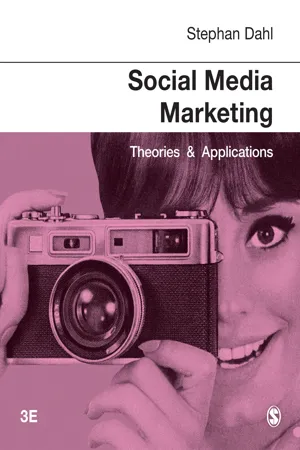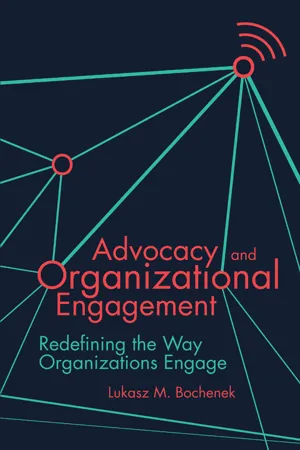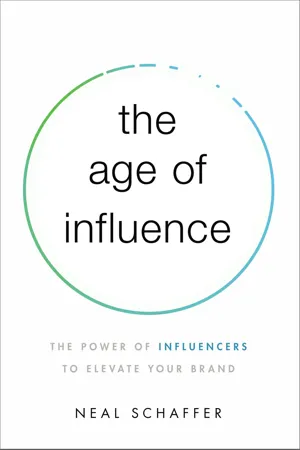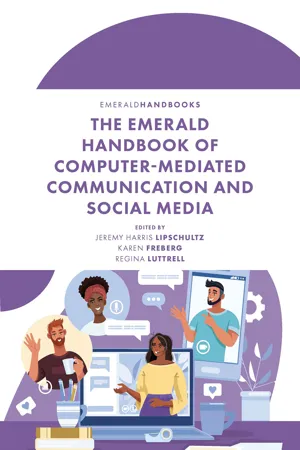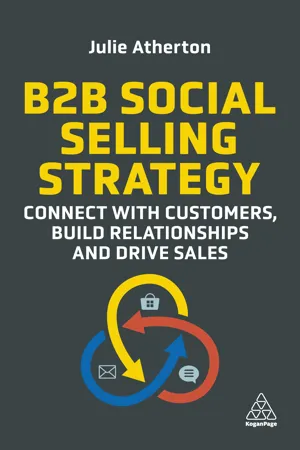Marketing
Influencer Marketing
Influencer marketing involves collaborating with individuals who have a strong online presence and a dedicated following to promote products or services. These influencers have the ability to sway the purchasing decisions of their audience through their authenticity and credibility. By leveraging the influencers' reach and influence, brands can effectively connect with their target market and drive engagement and sales.
Written by Perlego with AI-assistance
Related key terms
1 of 5
11 Key excerpts on "Influencer Marketing"
- eBook - ePub
- Kristy Sammis, Cat Lincoln, Stefania Pomponi, Jenny Ng, Edita Gassmann Rodriguez, Judy Zhou(Authors)
- 2015(Publication Date)
- For Dummies(Publisher)
What makes Influencer Marketing so compelling? For one thing, it simply couldn’t have existed before now. Influencer Marketing brings together age-old concepts but gives them a modern, social media twist, and then distributes them across platforms that change almost daily. And the results are stunning.We believe that Influencer Marketing is unprecedented and truly differentiates itself from the old marketing practices. In fact, it challenges most of them. This new medium pushes traditional boundaries — and that’s a good thing! Consumers (the folks we’re marketing to) are savvier than ever. It’s our job to keep up.In this chapter, we give you an overview of what Influencer Marketing is and why it matters to you — whether you know it or not!Defining Influencer Marketing
So, what is Influencer Marketing exactly, and why are we so darn excited about it? Influencer Marketing is the art and science of engaging people who are influential online to share brand messaging with their audiences in the form of sponsored content.Advertisers have always used celebrity endorsements as a way to increase awareness and improve perception of a brand, because people tend to trust celebrities they admire, and sometimes aspire to be like them. Influencer Marketing is similar in concept, but it has ushered in a new way to define celebrity. In addition to TV and movie stars, pro athletes, and musicians, celebrities of the social media world exist now, too. People can build big, engaged audiences on social media, such as blogs or Instagram. And those social media influencers wield influence over their audiences, akin to celebrity influence. Brands then work with these social media influencers to create a new kind of celebrity endorsement.For example, maybe a new energy drink has just come out, and they want to market themselves as a “perfect boost for busy women.” They decide that — in addition to email blasts, online display ads, and in-person events — they’re going to reach out to influential female bloggers who write about their busy lives (and include information about the new energy drink). To engage these influencers, the energy drink’s marketing team will - eBook - PDF
- Stephanie Diamond(Author)
- 2022(Publication Date)
- For Dummies(Publisher)
What makes Influencer Marketing so compelling? For one thing, it simply couldn’t have existed before now. Influencer Marketing brings together age-old concepts but gives them a modern, social media twist, and then distributes them across platforms that change almost daily. And the results are stunning. Influencer Marketing is unprecedented and truly differentiates itself from the old marketing practices. In fact, it challenges most of them. This medium pushes traditional boundaries — and that’s a good thing! Consumers (the folks you’re marketing to) are savvier than ever. It’s your job to keep up. In this chapter, you get an overview of what Influencer Marketing is and why it should matter to you — whether you know it or not! Chapter 1 IN THIS CHAPTER » Getting the lay of the land » Redefining “influence” » Knowing what your business needs to launch successful programs 414 BOOK 6 Targeting Your Work with Influencers Defining Influencer Marketing So, what is Influencer Marketing exactly? Influencer Marketing is the art and science of engaging people who are influential online to share brand messaging with their audiences in the form of sponsored content. Advertisers have always used celebrity endorsements as a way to increase aware- ness and improve perception of a brand, because people tend to trust celebrities they admire, and sometimes aspire to be like them. Influencer Marketing is simi- lar in concept, but it has ushered in a new way to define celebrity. In addition to TV and movie stars, pro athletes, and musicians, celebrities of the social media world exist now, too. People can build big, engaged audiences on social media, such as through blogs or Instagram. And those social media influencers wield influence over their audiences, akin to celebrity influence. Brands then work with these social media influencers to create a new kind of celebrity endorsement. - eBook - ePub
Social Media Marketing
Theories and Applications
- Stephan Dahl(Author)
- 2021(Publication Date)
- SAGE Publications Ltd(Publisher)
With consumers spending more time on social media, they also make more purchasing decisions based on information gathered, asked for or looked up online. People they follow, and who are appearing as experts online, are highly influential in influencing these decisions. This is the domain of Influencer Marketing. Simply put, Influencer Marketing engages ‘influencers’, that is to say social media opinion leaders, for marketing purposes.This chapter concentrates on discussing the phenomenon of the influencer – and how this phenomenon relates to marketing on social media. In order to promote, influencers use a number of techniques which are the focus of later chapters. Specifically, influencers use persuasiveness (Chapter 8 ), they create a form of word of mouth (Chapter 10 ) and their engagement level (Chapter 9 ) is often used to evaluate their activities.Influencer Marketing is closely related to two traditional marketing techniques: endorsements and product placement, and shares many parallels with(e)WOM(see Chapter 10 ). However, it is different from traditional (media) endorsements, in that Influencer Marketing uses social media personalities and not traditional celebrities, who often have no expertise in relation to the endorsed products.Influencer Marketing is also different from eWOM, as eWOM largely relies on product reviews. That is to say, there isn’t a longer lasting relationship between the reviewer and the reader of a review. In short, a follower is likely to engage with an influencer over an extended period and following many posts by this influencer. Conversely, in eWOM, the interaction of reviewer and reader is usually only a single review or piece of information.Table 4.1In practice, Influencer Marketing works by convincing, mostly by paying, influencers to endorse products on their channel: such as a sport influencer talking about a specific brand. A marketeer can also get products ‘placed’ in the content generated by influential social media personalities. An example of the latter is a travel blogger posting pictures of a hotel they are staying in while travelling. - eBook - ePub
Digital Marketing
The Science and Magic of Digital Marketing Can Help You Become a Successful Marketing Professional (English Edition)
- Rajan Gupta, Supriya Madan(Authors)
- 2022(Publication Date)
- BPB Publications(Publisher)
You may want to take a look at the content consumption if your success metrics call for it. Who are the people who are interested in what you have to say? What is their place of origin? You may also check how much or how little is being provided and the number of visitors engaging with your material. Here are a few things to consider while doing your measurements.- Voice-sharing
- Engagement
- Influence
- Awareness
- Popularity
Influencer Marketing
With over 80% of consumers reporting that social media—especially influencer content—significantly impacts buying decisions, marketers across industries are driving the evolution of social media marketing (SMM ) from a stand-alone tool to a multipronged source of marketing intelligence on an increasingly important—and growing—audience.6Brands need to know exactly what Influencer Marketing is if they are going to use it effectively. To put it simply, Influencer Marketing involves the practice of using social media influencers to spread the word about certain products, services, or campaigns. The goal here is to collaborate with an influencer who is now aligned with the brand and whose audience is likely to connect and also be interested in the product or offer, and also who is willing to do so. A partnership with the influencer is a great way to increase exposure for your company since their recommendations are widely respected by their followers. Influencer Marketing may be a great addition to the social media strategy since it enables you to connect with a specific, interested audience and improve your brand’s visibility. Here are seven reasons why Influencer Marketing should really be a component of your overall marketing plan: - eBook - ePub
Advocacy and Organizational Engagement
Redefining the Way Organizations Engage
- Lukasz M. Bochenek(Author)
- 2019(Publication Date)
- Emerald Publishing Limited(Publisher)
From a research perspective, it would be interesting to see more research around digital influence with a special focus on micro-influence. Some of the professionals suggest that the Influencer Marketing is one of the myths of the modern marketing. However, there is a contrary evidence that sets it as one of the most effective means to influence behaviors of the target audiences. It is also applicable beyond social media (Brown & Hayes, 2008). A large sample study looking at the channel and approach effectiveness would provide the insights and evidence to validate or reject this hypothesis.It would be also interesting to analyze the relationships between the brands and influencers from an ethnographic perspective. What are the main perceptions of each other, how do they find their cooperation, what are the main issues and benefits coming from these relationships – the answers to these questions would allow us to validate further the approaches toward Influencer Marketing as well as provide more insights into its working model.Key Takeaways- Digital engagement is more and more focused on individuals and individual engagement. Effective strategies need to bring a personalized dimension to keep delivering on relevance. This personalization means changing the way content is thought through and created. It also means building connections with those who matter the most.
- Social media and digital influence are both dynamic. They are also dependent on the context. There is no universal influence. Some individuals and organizations are very influential in one subject but have no influence in others. This requires constant research and questioning of the status quo and deep-listening to the landscape.
- Effective digital strategies require looking beyond digital. It is crucial to consider a social and cultural capital of an organization or individual while assessing their influencing power. For global advocacy strategies it is important to build relationships that happen not only in the virtual context, but also offline. This multi-touch, multi-channel approach delivers best long-term results.
- eBook - ePub
- Annmarie Hanlon, Tracy L. Tuten, Annmarie Hanlon, Tracy L. Tuten, Author(Authors)
- 2022(Publication Date)
- SAGE Publications Ltd(Publisher)
14 How Influencers Influence: Conceptualizing the Influencer Map for Marketing Karen Freberz, Brian G. Smith, and Lauren SilvaIntroduction
Influencers have been on the rise for public relations, marketing, and social media campaigns over the last few years as a key strategy to amplify, support, and create engagement through their means to foster a strong connection with a brand (or entity and organization) and their key publics. In fact, according to a research report by Influencer Marketing Hub (2019), there were 320 new influencer specific platforms that were created in the first part of 2019 alone to focus on this particular area in the social media industry. At the same time, influencers have also posed significant challenges for companies and their brands, including the questionable effect of influencers on company brand, reputation, and consumer decision-making (Zeljko et al., 2018).Researchers have explored influencers in several ways including based on their personality characteristics (Freberg et al., 2011), professional attributes and contributions (Enke & Borchers, 2019), community engagement (Himelboim & Golan, 2019; Smith & Taylor, 2017), building an online community (Childers et al., 2019), fostering trust online (Lou & Yuan, 2019), authenticity (Charlton & Cornwell, 2019), and adding on to their paid media role in formulating brand partnerships (Luoma-aho et al., 2019). Despite this focus on the tactical application of influencers, not much has been done to connect the theoretical concepts and integration of influencers in the academic literature. For one, influencers have hardly been differentiated in the literature from other related titles, like creators, brand ambassadors, and micro-celebrities. How they enact influence has also been underexplored, including how they tap into social media's nuances and unique cultural principles, and how they are integrated into practice (e.g. as partners, advocates). This chapter outlines a typology of influencers based on influencer persona and built from the central components of social media influence, to not only fill gaps in the literature, but to also advocate best practices for practitioners to implement in Influencer Marketing. - eBook - ePub
The Age of Influence
The Power of Influencers to Elevate Your Brand
- Neal Schaffer(Author)
- 2020(Publication Date)
- HarperCollins Leadership(Publisher)
PART TWO UNDERSTANDING INFLUENCERS AND THE WAYS YOU CAN ENGAGE WITH THEMThe rise of social media and the development of our online personalities mean everyone has some online presence. An influencer is anyone with an audience and a platform, who has weight with their followers. Chances are you’re in touch with influencers more than you realize. The key to leveraging their influence is finding who fits with your message.One question that often arises: “Why would an influencer want to work with me?” Mutual benefit. The influencer gets something from you, too. And it’s not always money. Selecting the right influencer is important. There’s a way to find out if what you and the influencer want are the same thing, and how you can work together to achieve goals for both of you.Working with an influencer isn’t a one-time deal. As I like to put it: Influencer Marketing is a marriage, not a one-night stand. A one-time campaign can bring quick results but the true power of engaging with an influencer, and the large-scale return, comes when you develop a relationship.Passage contains an image
6UNDERSTANDING THE INFLUENCER LANDSCAPEThe Different Types and Levels of InfluencersT he definition of an influencer is as broad as the definition of influence. By taking a look at the different types and levels of influencers, you will begin to better picture those influencers who will best fit your company’s plans.When we talk about the kinds of influencers we can work with and how they fit with the entire social media landscape, we have to remember why influencers exist in the first place. People make decisions based on advice from people they trust. Increasingly, though, we are influenced by people we don’t know personally but have gotten to know through social media.Beyond this, people want to hear from trusted voices with authority. Traditionally speaking, the trusted sources were businesses and the media. There were—and still are—entire departments within companies responsible for media relations, ensuring brand messages were released to the appropriate people. Brands had spokespeople to make statements to people with influence who would then broadcast the message to their viewers, listeners, or readers. This is essentially pre-social media content sharing through the “clips” of press releases. - Jeremy Harris Lipschultz, Karen Freberg, Regina Luttrell, Jeremy Harris Lipschultz, Karen Freberg, Regina Luttrell(Authors)
- 2022(Publication Date)
- Emerald Publishing Limited(Publisher)
Others rely on personal reputation and content quality when finding SMIs to work with (Navarro et al., 2020). Still, other practitioners turn to technology to identify influencers. After interviewing public relations practitioners in Australia, Davies and Hobbs (2020) found that practitioners often relied on analytics and intelligence platforms to identify influencers for their clients and cited the ability to predict influence and “cut through the noise” as reasons for relying on the technology. This is one area where academic scholars and practitioners can come together to work on a solution that can potentially improve Influencer Marketing. Future Research The study of influencers and Influencer Marketing is a burgeoning area in public relations, marketing, advertising, and strategic communication. Even though the underlying concept of influencers is not new (opinion leadership and two-step flow theory), the social media components add an interesting layer of complexity to the study of influencers that is rife for scholars and practitioners alike to explore. Researchers have started examining the influencer–follower relationship, but fewer studies have looked explicitly at the influencer–brand relationship. One such area related to the influencer–brand relationship is the need to develop effective strategies for identifying influencers. Another area related to influencer–brand relationships that warrants continued study is the risks and benefits associated with Influencer Marketing. Other scholars call for more research on influencers and online brand engagement (Hughes et al., 2019), which could advance our understanding of the effectiveness of Influencer Marketing techniques. If Influencer Marketing continues to grow, then scholarly and industry-focused work should be done to better understand the SMI as a profession- eBook - ePub
The Dynamics of Persuasion
Communication and Attitudes in the 21st Century
- Richard M. Perloff(Author)
- 2023(Publication Date)
- Routledge(Publisher)
Influencer Marketing, a recent craze, calls on communicators with clout with their target audience (from promoters prominent on social media to everyday college students). Influencers (the name begging the question of whether they actually influence) cash in on time-honored communicator techniques, such as likability, similarity, and parasocial relationships. Influencer Marketing works not simply through timeworn appeals, like number of tweets, but through the visual content of posts and their ability to inspire young followers to identify with influencers’ distinctive online shtick. Indeed, followers can form close, vicarious relationships with influencers, fulfilling social adjustive functions, while allowing influencers to promote products and make a living.As au courant as these techniques are, these is no guarantee they will succeed just because they are relayed digitally with social networking glitz. Marketing effectiveness depends on just the right dose of psychology, creative marketing, and aesthetic appeal. We still do not understand exactly what makes for a successful marketing campaign, for it involves a number of elusive psychological and communication strategies, working in just the right manner, until it becomes passé.Needless to say, as an instrument of contemporary capitalism, with its economic strengths and social inequities, advertising has generated considerable criticism. Long controversial, advertising has been condemned on deontological grounds by those who point to the obvious falsehoods that ads contain. Other critics lament that advertising inculcates a strange philosophy of life that places great faith in the ability of products to satisfy universal human desires.Advertising’s defenders are nonplussed. Chill out, they say. People don’t believe all of what advertising says and they enjoy watching the clever “magic tricks” ads employ, for example on Super Bowl Sunday. Besides, defenders note, humans’ desire to acquire cool gadgets drives advertising. If people did not love things and the status products convey, advertising could not prosper.In the final analysis, advertising and commercial marketing remain ethically problematic, but necessary, parts of capitalist society. Needed to differentiate and promote products, advertising increases demand, helping business to sell products and employ workers. But questions about falsehood and manipulation persist. Advertising remains, in Schudson’s (1986) - eBook - ePub
B2B Social Selling Strategy
Connect with Customers, Build Relationships and Drive Sales
- Julie Atherton(Author)
- 2022(Publication Date)
- Kogan Page(Publisher)
08Using B2B social media influencers
Making the most of influencer relationshipsInfluence is in the DNA of social media and this chapter unpicks the wide range of opportunities available to you. Learn how to find B2B influencers and gain tips on how to both work with influencers and become more influential yourself.How social media influencing is changing
The world of influencers is changing as it matures. Although celebrities are still important to some brands, and payment per post still exists, for the majority of businesses their motivations for working with influencers have changed and therefore so has the type of influencer they choose. What has driven this transition is an increasing belief in transparency and authenticity, and a recognition of the importance of enabling creative autonomy when working with a creator network. This change can only be delivered by a long-term partnership and shared values and interest areas, both of which are much more likely to be delivered by smaller influencers, customers and employees.In my 2020 book Social Media Strategy I discuss how influencers encompass a wide range of individuals, from top-tier influencers to employees. I also recognize that it is the increasing long-term partnership approach with smaller influencers and employees that is making a significant contribution to influencer growth.Top-tier influencers include professional influencers and celebrities. They have large followings, can be extremely expensive to work with and will be followed by their community for lots of different reasons, one of which might be something in common with your brand or business. For example, in the B2B world Richard Branson could be considered a celebrity influencer. He is a famous entrepreneur and business leader. However, he is also famous for ballooning, commercial ventures in multiple sectors and going into space. If you were able to persuade him to influence on your behalf, you would risk being lost in the noise of his multiple interests. - eBook - PDF
- Amy Will(Author)
- 2021(Publication Date)
- For Dummies(Publisher)
3. Whittle down your list of candidates based on their rates and the quality of their work. 4. Contract the top candidate on your list. Make sure that your contract covers the following: • Both parties’ contact info. • Rate/price. • Deadline/timeline. • Ownership of content produced. (Normally, the photographer/videographer retains the copyright and grants you use rights, but this aspect is negotiable.) • Statement of who’s responsible for obtaining signed model and property releases so that you have legal permission to show the model and location. • Details on postproduction editing and any additional costs associated with it. • Cancellation policy. Have your attorney prepare the contract or review the vendor’s contract before signing anything. Teaming Up with Influencers Influencer Marketing is a form of social media marketing involving product place -ment and recommendations from people whose opinions many other people know and trust. This type of marketing is a great way to increase brand exposure and reach. Just imagine the exposure your brand would get if an Instagram user with more than 50,000 followers started posting about it! The key to successful Influencer Marketing is choosing people who are active on social media and who have a large audience that’s likely to be interested in your brand. If you’re selling clothing made from recycled materials, for example, get -ting an endorsement from an influential environmentalist or group could be very helpful. CHAPTER 13 Promoting Your Brand via Social Media 231 Before you start recruiting candidates, you have two choices to make: micro influ -encer versus macro influencer and paid versus organic. Micro influencer versus macro influencer Influencers are often divided into two categories: micro influencers, who have 10,000 to 100,000 followers, and macro influencers, who have more than 100,000 followers.
Index pages curate the most relevant extracts from our library of academic textbooks. They’ve been created using an in-house natural language model (NLM), each adding context and meaning to key research topics.
